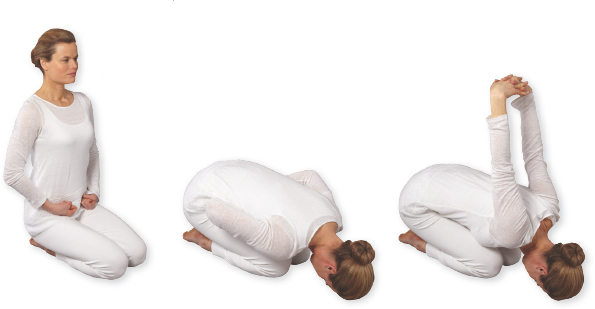
MIND MUDRAS
INCREASING CONCENTRATION AND CLARITY
Part of hand: palm
Element: mind
Related chakra: third eye
Physical associations: overall control of the body and senses
Emotional associations: concentration, intuition, intelligence, insight
‘Yoga is the experience you have when your mind is peaceful.’
Patanjali, Yoga Sutra
In Indian philosophy the palms relate to the mind and to the ajna chakra in the centre of the brow. The palms control your fingers and their five linked elements just as your mind controls your actions and senses. The mind is beyond all elements, but controls the five elements in your body as well as the associated senses. By practising these mudras, you bring balance and focus to the mind and clarity to the senses
In Sanskrit, the mind is referred to as chitta, meaning an individual’s consciousness. This encompasses your intelligence, emotions, thoughts, memories and dreams, as well as your conscious and sub-conscious mind. Chitta, or mind, may be likened to a lake on which waves of thought rise and fall constantly, sometimes gently and at other times more violently. When the waves are still, you can see the bottom clearly. Likewise with the mind: when disturbing thoughts subside – for example when you practise these mudras – your mind becomes peaceful and life comes into focus.
Some of the mudras in the chapter involve joining the palms of both hands. This helps to balance the rational and logical thoughts of the left side of the brain with the intuitive non-linear thinking of its right side, enhancing abstract thinking, intuition, imagination, concentration, mental discipline, insight and your ability to understand symbols and signs. Other mudras work on brain integration, better equipping you to remember words on the tip of your tongue or to put names to faces.
Mudras that apply pressure to your palm can – depending on which finger you use – enhance contentment, concentration and the ability to meditate, while relieving such problems as confusion or mental fogginess, poor memory, migraines and insomnia. Many of these mudras are easily practised at work, making them useful for boosting performance and efficiency, too.
The palm is linked to the ajna chakra, commonly referred to as the ‘third eye’ or ‘mind’s eye’. This is the command centre of your subtle body; the inner instrument that controls your five senses, all the other chakras and the nadi energy highways feeding into them (see pages 14–15).
In your physical body, your brow chakra governs your eyes, ears, nose and the region of the base of your skull. An energetic imbalance or blockage of this chakra may contribute to symptoms including vision problems, headaches, dizziness and acute sinusitis. You can relieve many of these problems by working with palm mudras.
Emotionally, practising these mudras can enhance your intuition and give you clearer insight into your life purpose. They may help you to become a more imaginative person, with the ability to think symbolically as well as literally. In addition, working with palm mudras is an excellent way to enhance determination, overcome obstacles, counter fear and relieve an overactive mind.
The palms also contain minor chakras – your hand or palm chakras – and bringing both palms together stimulates these, leading to the easy expression of joy. Notice how when you feel happy or have enjoyed something, you quite naturally clap your hands. I hope that the mudras in this chapter encourage you to put your hands together – in joy or as an expression of peace and contentment.
Mind mudras at a glance |
||
Mudra |
Benefit |
Page |
Ajna |
Helps you to plan for the future |
134 |
Nirvana |
Overcomes resistance to change; awakens compassion |
135 |
Bhairava |
Supports resolution to remain peaceful; aids meditation |
136 |
Ganesha |
Builds self-confidence and courage; helps in facing difficult situations; fosters compassion and respect for others |
137 |
Namaskar |
Reduces stress; balances energy within body; assists inward focus |
138 |
Anjali |
Boosts gratitude, compassion and generosity; decreases greediness; lowers blood pressure; balances digestive system |
139 |
Abhaya |
Instils attitude of fearlessness that will inspire others |
140 |
Varada |
Encourages forgiveness; improves focus; offers new insight |
141 |
Handshake |
Offers friendship and encourages others to open up |
142 |
Hakini |
Boosts memory and intuition; enhances intellectual capacity |
144 |
Samasti |
Balances intuitive and rational thinking; aids communication |
145 |
Maha-shirsha |
Relieves headaches and sinus congestion; reduces tension; helps clear an overactive mind |
146 |
Mandala |
Enhances overall wellbeing, relieving health problems and protecting from negativity |
147 |
Mushti |
Releases frustration; protects heart; lowers blood pressure |
148 |
Sensitizing the Hands
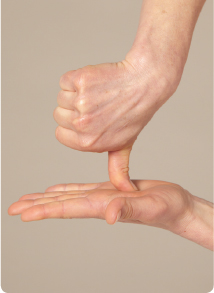
What do you do when you bang your elbow or knee, or feel tired or achey? Without thinking, you rub the painful area with the palm of your hand. You use the energy centres in the palms of your hands all the time to stimulate a flow of healing energy. This exercise helps to sensitize your hands by activating the minor chakras in your palms. With practice, it can help you to start experiencing energy on a more subtle level and eventually to transmit healing prana to yourself and other people.
The oils used in the accompanying massage below enhance your compassion, your sensitivity to other people’s energy and your ability to comfort others in times of sorrow or grief.
HOW TO PRACTISE
Come into a sitting position (see pages 20–21). Rest one hand on top of the other palm and gently press the centre of the top palm with the thumb of your opposite hand. Sense the location of your hand chakras and notice any sensations. Hold for 3–5 seconds. Swap hands and repeat.
HOW IT WORKS
While not actually a mudra, this exercise sensitizes your palms and prepares you to practise any of the mudras in this chapter.
 ACCOMPANYING MASSAGE: AS YOU PRESS THE PALMS, MASSAGE IN ½ TEASPOON OF SWEET ALMOND OIL OR OLIVE OIL CONTAINING 1 DROP OF ESSENTIAL OIL OF ROSE (FOR CHANNELLING LOVING ENERGY AND COMFORT), MELISSA (FOR BALANCING WILLPOWER AND COMPASSION) OR LAVENDER (FOR INCREASING SENSITIVITY TO OTHERS).
ACCOMPANYING MASSAGE: AS YOU PRESS THE PALMS, MASSAGE IN ½ TEASPOON OF SWEET ALMOND OIL OR OLIVE OIL CONTAINING 1 DROP OF ESSENTIAL OIL OF ROSE (FOR CHANNELLING LOVING ENERGY AND COMFORT), MELISSA (FOR BALANCING WILLPOWER AND COMPASSION) OR LAVENDER (FOR INCREASING SENSITIVITY TO OTHERS).
HAND SENSITIZING
IN A MOVEMENT PRACTICE
Sensing a Ball of Subtle Energy
This exercise further sensitizes your palms and brings you in contact with your ability to experience and transmit energy. Don’t confuse the subtle energy you experience with body heat; it is more like a magnetic field floating between your palms.
Placing your tongue flat against the roof of your mouth, as is done in this exercise, helps to silence a busy mind.
1 While sitting or standing, extend both arms in front of you. Keep them parallel to the ground with your elbows straight. Turn your arms so that one palm faces up and the other down.
2 Gently seal your lips and place the tip of your tongue on the hard ridge on the roof of your mouth; keep it there throughout the exercise as you breathe through your nostrils.
3 Make fists and release them quickly, opening and closing your hands 20–30 times.
4 Reverse the direction of your hands so the palm that was facing up is now down, and vice versa. Repeat the opening and closing movement 20–30 times.
5 Turn your palms to face each other, keeping your hands open. Slowly bring your palms toward each other. When they are about 10cm (4in) apart, see if you can sense a subtle ball of energy. Move your palms away from each other and back again to help to locate it.
6 Close your eyes and play with the energy, bouncing it from hand to hand. Then move your hands in a circle, first in one direction, then the other. When you have finished, gently shake out your hands.

Brow Chakra Gesture
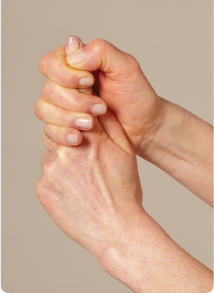
This is the key mudra of ajna, the brow chakra, the seat of your judgment, emotional intelligence, rational thought, intuition and wisdom. When this chakra is in balance, your vision is clear; you are able to see the ‘bigger picture’ and even become open to psychic perception. Practising Ajna Chakra Mudra helps you to recognize the various patterns in your life for what they really are. Practise it whenever you feel the need to ‘see’ where something is leading you or to plan for the future.
HOW TO PRACTISE
You can practise in any stationary position. Raise your left hand in front of your face. Gently curl all the fingers of your left hand into the palm, making a loose fist with your thumb on the outside. Release your index finger and extend it upward. Bring the fingers of the right hand around the extended left index finger, using your right thumb to gently press on the outside edge of the nail. Hold for 1–2 minutes.
HOW IT WORKS
By stimulating the finger you use to point on the left side of your body, you motivate the right hemisphere of the brain to give you direction. Working with both hands helps to bring all viewpoints into balance.
 ACCOMPANYING CHANT: TO OPTIMIZE THE BENEFITS OF THIS MUDRA, CLOSE YOUR EYES AS YOU HOLD THE MUDRA AND MENTALLY REPEAT THE MANTRA OF THE AJNA CHAKRA, ‘OM’
ACCOMPANYING CHANT: TO OPTIMIZE THE BENEFITS OF THIS MUDRA, CLOSE YOUR EYES AS YOU HOLD THE MUDRA AND MENTALLY REPEAT THE MANTRA OF THE AJNA CHAKRA, ‘OM’
Liberation Gesture
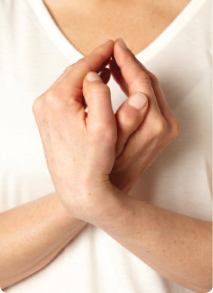
Everything in life is subject to change, and Nirvana Mudra helps you to stop clinging to the unhelpful thought that things can stay the same. This mudra is used in the yoga tradition to awaken compassion, reduce selfishness and liberate you from the cycle of birth, death and rebirth. The word nirvana literally means ‘extinguished’ – like a candle blown out.
HOW TO PRACTISE
Come into a sitting position (see pages 20–21) or stand. Stretch your arms in front of you, cross your wrists and bring your palms together. Rotate your joined hands first down, then in toward your body and up, so all your fingers point upward. Your palms will bow out slightly, but try to keep each fingertip pressing against its opposite finger. Keep your thumbs side by side and elbows as close together as possible. Bow your head slightly so your fingertips come closer to your brow chakra. Hold for 10–60 seconds or longer. Release your hands, shake out and repeat with wrists crossed the opposite way.
HOW IT WORKS
As the tips of all your fingers join, all your elemental energies balance and are brought under the control of your mind, represented by your palms.
 ACCOMPANYING CHANT: EMPOWER THE MUDRA WITH THE PEACE MANTRA: ‘A-SATO MA, SAT GA-MA-YA / TA-MA-SO MA JYO-TIR GA-MA-YA / MRIT-YOR-MA A-MRI-TAM GA-MA-YA’ – ‘LEAD ME FROM THE UNREAL TO THE REAL, FROM DARKNESS TO LIGHT, FROM DEATH TO IMMORTALITY.’ ‘OM SHANTI SHANTI SHANTI OM’ – ‘PEACE PEACE PEACE’.
ACCOMPANYING CHANT: EMPOWER THE MUDRA WITH THE PEACE MANTRA: ‘A-SATO MA, SAT GA-MA-YA / TA-MA-SO MA JYO-TIR GA-MA-YA / MRIT-YOR-MA A-MRI-TAM GA-MA-YA’ – ‘LEAD ME FROM THE UNREAL TO THE REAL, FROM DARKNESS TO LIGHT, FROM DEATH TO IMMORTALITY.’ ‘OM SHANTI SHANTI SHANTI OM’ – ‘PEACE PEACE PEACE’.
Fierce Determination Gesture

Hold this mudra when you find yourself in a situation that requires you to be fiercely determined to remain peaceful. This is a traditional meditation mudra, and the one most commonly used in Buddhist groups. In Hindu and Buddhist mythology, Bhairava takes a fierce or terrifying form and has the power to destroy the negativity associated with your lower nature to allow more positive qualities to emerge.
HOW TO PRACTISE
Come into a sitting position (see pages 20–21) and place your hands in your lap – on a small cushion if it feels more comfortable. Rest your right hand on top of your left, with both palms facing upward. Allow your joined hands to rest in your lap. Hold for as long as feels comfortable and repeat as required. As a variation, repeat with the left hand on top, which accentuates the fierce feminine energy of the mudra and is known as Bhairavi Mudra.
HOW IT WORKS
Joining your hands in this way enhances peaceful communication between the two hemispheres of your brain. In terms of yoga philosophy, you bring about the union of two of the main nadis, or energy pathways (see pages 12–13): the ida channel that flows to the left of your spine and the pingala to the right.
 PERSONAL EXPERIENCE: ‘KEEPING MY PALMS TOGETHER IN THIS WAY GAVE ME A SENSE OF SUPPORT, AS THOUGH I WAS SUPPORTED BY THE UNIVERSE. I FELT LIGHT AND MORE ENERGETIC.’
PERSONAL EXPERIENCE: ‘KEEPING MY PALMS TOGETHER IN THIS WAY GAVE ME A SENSE OF SUPPORT, AS THOUGH I WAS SUPPORTED BY THE UNIVERSE. I FELT LIGHT AND MORE ENERGETIC.’
Remover of Obstacles
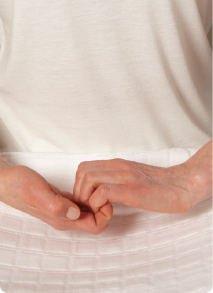
This gesture builds self-confidence and courage, instils in you the courage and willpower to face difficult situations, and fosters compassion and respect for other people. Physically, Ganesha Mudra has a powerful effect on the veins and bronchial tubes, encouraging them to open. Ganesha is a favourite Indian deity, with many admirers in the West, too. He represents the energy that removes problems that get in your way. This is relatively easy for him to do, since he is the one who puts obstacles there in the first place. His goal in doing that is to make you physically, mentally and emotionally stronger.
HOW TO PRACTISE
Come into a sitting position (see pages 20–21), stand or lie down. Have your right hand palm up and place your left palm face down over it. Bend all your fingers and hook them together. Keep your joined hands at waist level or rest them in your lap. Hold for as long as feels comfortable without moving. Repeat as required, for example during difficult meetings or when standing on a crowded commuter train.
HOW IT WORKS
Hooking the fingers brings all five elements together, and as the palms press against each other, your mind joins them to give strength and determination to body and mind.
 ACCOMPANYING EXERCISE: TO MAKE THIS A MORE DYNAMIC PRACTICE, WHILE HOLDING THE MUDRA EXHALE AND GENTLY PULL YOUR HANDS N OPPOSITE DIRECTIONS; INHALE AND RELAX. REPEAT SIX TIMES, THEN CHANGE THE CROSS OF YOUR HANDS AND REPEAT.
ACCOMPANYING EXERCISE: TO MAKE THIS A MORE DYNAMIC PRACTICE, WHILE HOLDING THE MUDRA EXHALE AND GENTLY PULL YOUR HANDS N OPPOSITE DIRECTIONS; INHALE AND RELAX. REPEAT SIX TIMES, THEN CHANGE THE CROSS OF YOUR HANDS AND REPEAT.
My Essence Meets Your Essence Gesture
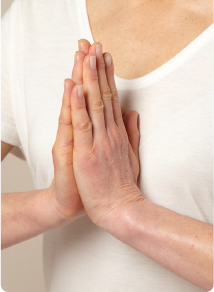
The word namaskar means ‘I salute your essence’, and this symbol of greeting used in India since ancient times is perhaps the best known of the mudras. Practising this graceful mudra reduces stress, balances the energies on the right and left sides of the body, and assists you in drawing your mind inward.
Usually you hold your hands in front of your breastbone when greeting people with this gesture. Holding it in front of your face is a sign of great respect, sometimes accompanied by a slight bow of the head. Holding your hands over your head indicates that you are saluting a higher power.
You might see this gesture referred to as ‘Namaste’ and many yoga practitioners call it Anjali Mudra, not to be confused with the Anjali Mudra opposite. In the West, Namaskar Mudra is commonly known as ‘prayer position’.
HOW TO PRACTISE
Come into a sitting position (see pages 20–21) or stand. Bring both palms together, flat against each other with all your fingers pointing upward. Bring your thumbs against your breastbone. Hold for as long as feels comfortable and repeat as required.
HOW IT WORKS
Joining both hands in this simple symmetrical way balances all your energies, connecting the energetic currents of your right-side, rational brain with those of your left-side intuitive brain.
 ACCOMPANYING EXERCISE: TO TRY THE INDIAN DANCE VERSION OF THE MUDRA, RAISE YOUR ELBOWS SO YOUR FOREARMS ARE PARALLEL TO THE GROUND AND YOUR HANDS ARE A HAND-WIDTH IN FRONT OF YOUR BREASTBONE.
ACCOMPANYING EXERCISE: TO TRY THE INDIAN DANCE VERSION OF THE MUDRA, RAISE YOUR ELBOWS SO YOUR FOREARMS ARE PARALLEL TO THE GROUND AND YOUR HANDS ARE A HAND-WIDTH IN FRONT OF YOUR BREASTBONE.
Gesture of Offering
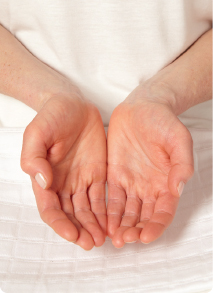
Practise this mudra to increase your capacity for gratitude, compassion and generosity. Anjali Mudra decreases greediness and grasping for more than you need, and on a physical level reduces stress, lowers blood pressure, and balances digestion and elimination. The Sanskrit word anjali means both ‘offering’ and ‘hands joined in reverence’. Traditionally in India, people get up before sunrise to bathe in a river or stream. There they face the rising sun and say morning prayers while holding their hands in this mudra to offer water. Anjali Mudra is often referred to as pushpanjali, or ‘offering of flowers’.
HOW TO PRACTISE
While standing, bring the little-finger sides of your hands together with palms cupped and facing upward. Tip your hands slightly so the fingers are just lower than the wrists, as though you have water in your hands and are pouring it out. Relax your shoulders and hold for as long as is comfortable
HOW IT WORKS
Joining and opening your hands with palms facing up indicates that you are giving with an open heart and desire to receive inspiration.
 ACCOMPANYING VISUALIZATION: HOLDING THIS MUDRA, CLOSE YOUR EYES AND BRING YOUR AWARENESS TO YOUR HEART. PICTURE AN ISLAND N AN OCEAN OF NECTAR, WITH FRAGRANT FLOWERING TREES. FOCUS ON THE MOST BEAUTIFUL TREE, THE KALPA-VRIKSHA (WISHING TREE). ASK FOR GUIDANCE. WHEN READY, OPEN YOUR EYES AND TAKE 2–3 DEEP BREATHS.
ACCOMPANYING VISUALIZATION: HOLDING THIS MUDRA, CLOSE YOUR EYES AND BRING YOUR AWARENESS TO YOUR HEART. PICTURE AN ISLAND N AN OCEAN OF NECTAR, WITH FRAGRANT FLOWERING TREES. FOCUS ON THE MOST BEAUTIFUL TREE, THE KALPA-VRIKSHA (WISHING TREE). ASK FOR GUIDANCE. WHEN READY, OPEN YOUR EYES AND TAKE 2–3 DEEP BREATHS.
Have No Fear Gesture
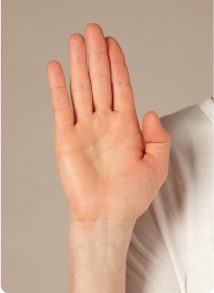
This is an instinctive gesture that parents might use to calm a fearful child with the promise, ‘Don’t worry, I’m here.’ The Sanskrit word abhaya literally means ‘no fear’, and the mudra conveys a promise of protection. It is an ancient gesture of friendship and benevolence often depicted in paintings and statues of buddhas and other Eastern deities and teachers.
A Buddhist legend relates that when the Buddha was being attacked by an angry elephant, he simply held his hand in Abhaya Mudra. Immediately, the raging animal became calm. Bringing your own hand into this mudra instils in you a similar attitude of fearlessness that extends out to everyone who comes into contact with you.
HOW TO PRACTISE
Come into a sitting or kneeling position (see pages 20–21) or stand up. You practise this mudra with one hand, usually the right hand. Bend your elbow and bring your hand up to shoulder level. Flatten your palm and extend it to face outward, keeping your fingers together and pointing up. Hold for as long as feels comfortable and repeat as required.
HOW IT WORKS
Extending and flattening your palm transmits your thoughts of fearlessness out into your environment.
 ACCOMPANYING VISUALIZATION: TO HELP SOMEONE WHO IS ILL OR GOING THROUGH A DIFFICULT TIME, SIT FOR A FEW MINUTES WITH YOUR HAND IN THIS MUDRA. CLOSE YOUR EYES AND VISUALIZE SENDING POSITIVE THOUGHTS AND HEALING ENERGIES TO THAT PERSON.
ACCOMPANYING VISUALIZATION: TO HELP SOMEONE WHO IS ILL OR GOING THROUGH A DIFFICULT TIME, SIT FOR A FEW MINUTES WITH YOUR HAND IN THIS MUDRA. CLOSE YOUR EYES AND VISUALIZE SENDING POSITIVE THOUGHTS AND HEALING ENERGIES TO THAT PERSON.
Forgiveness Gesture

In this gesture of ‘open-handed’ generosity, the five fingers symbolize the following attributes: generosity, morality, patience, effort and meditative concentration. The Sanskrit word varada means ‘favourable’, and in Hindu, Jain and Buddhist iconography Varada Mudra represents charity, gift-giving and the granting of wishes. Try it when you wish to give yourself or others the gift of forgiveness. It also improves your concentration and offers you new insight.
HOW TO PRACTISE
Come into a sitting position (see pages 20–21). Practise this mudra with your left hand. Let your left arm hang down, with the elbow slightly bent, and rest the back of your wrist on your left knee so your hand is in front of the knee with the palm flat and facing outward. Keep your fingers together and pointing down. Hold for as long as feels comfortable; repeat as required.
HOW IT WORKS
Bringing all your fingers together indicates that all your elemental energies are united. Having the hand facing down demonstrates an attitude of humility and loving generosity.
 ACCOMPANYING MEDITATION: HOLDING THE MUDRA, THINK OF ALL THE WAYS YOU HAVE HURT YOURSELF WITH NEGATIVE OR CARELESS THOUGHTS, WORDS OR ACTIONS. REPEAT MENTALLY: ‘FOR ALL THE TIMES I HAVE HURT MYSELF THROUGH ACTION OR INACTION, OUT OF FEAR OR CONFUSION, FORGIVE MYSELF. I HAVE CARRIED THIS PAIN TOO LONG. NOW I LET IT GO.’
ACCOMPANYING MEDITATION: HOLDING THE MUDRA, THINK OF ALL THE WAYS YOU HAVE HURT YOURSELF WITH NEGATIVE OR CARELESS THOUGHTS, WORDS OR ACTIONS. REPEAT MENTALLY: ‘FOR ALL THE TIMES I HAVE HURT MYSELF THROUGH ACTION OR INACTION, OUT OF FEAR OR CONFUSION, FORGIVE MYSELF. I HAVE CARRIED THIS PAIN TOO LONG. NOW I LET IT GO.’
Shared Gesture

In many cultures, people greet each other, offer congratulations or express gratitude with a handshake. It can signal agreement, be a sign of good sportsmanship or seal a contract. The custom of shaking hands is an ancient gesture of peaceful intent, showing you hold no weapons. This is both a formal gesture and an intimate one, drawing another person to you while setting safe boundaries. When you shake hands, you exchange prana (subtle energy) and influence the impression you leave on others. Use this mudra to offer friendship and encourage others to open up to you.
HOW TO PRACTISE
You will need a partner. Practise with your right hand (most people are right-handed). Stand facing your partner and extend your right arm, elbow slightly flexed. Hold your hand vertically, all four fingers together and thumb up slightly. Contact your partner’s hand and gently wrap all five fingers around it; make sure your palms connect. Adjust your grip to the other person’s: don’t squeeze tightly but avoid a limp hand. A typical handshake consists of 2–4 up-and-down shakes, or simply hold for 3–4 seconds. Keep your left arm relaxed and your left hand unclenched by your side.
HOW IT WORKS
Joining palms ensures an energy exchange that allows you to sense the other person’s sincerity and assure them of yours.
 ACCOMPANYING INTENTION: AS YOU SHAKE HANDS, MAKE EYE CONTACT WITH A GENUINE SMILE. FEEL THE TRANSFORMATION THIS INTENTION BRINGS TO YOUR EYES AND FACE, EXPRESSING YOUR OPENNESS AND PLEASURE AT ENCOUNTERING THE OTHER PERSON.
ACCOMPANYING INTENTION: AS YOU SHAKE HANDS, MAKE EYE CONTACT WITH A GENUINE SMILE. FEEL THE TRANSFORMATION THIS INTENTION BRINGS TO YOUR EYES AND FACE, EXPRESSING YOUR OPENNESS AND PLEASURE AT ENCOUNTERING THE OTHER PERSON.
Handshake Variations
In Vedic palmistry, the palm of the hand is said to indicate who you really are, while your fingers show only what you want to reveal, so variations in hand position while shaking hands allow you to convey slightly different information to the person you are greeting. Holding the hand vertically in the Handshake Mudra, for example, demonstrates an equal relationship with the other person. With all variations, add a smile in order to communicate self-confidence and sincerity.
VARIATION 1

Stand facing your partner and extend your right arm, elbow slightly flexed. Tilt your hand slightly so that your palm is facing upward. Then contact your partner’s hand as opposite. This conveys a subtle message that you are willing to help the other person.
VARIATION 2
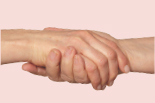
If you tilt your hand slightly so that your palm is facing downward before you contact your partner’s hand, you convey a subtle message that you feel superior in some way to the other person, so it is best not to use this variation.
VARIATION 3
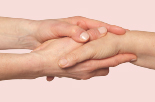
Stand facing your partner and extend your right arm, elbow slightly flexed. Hold your hand vertically and contact your partner’s hand as above, then use your left hand to cocoon the hand. This ‘hand-hug’ is seen as the friendliest and most trustworthy form of handshake.
Problem-solving Gesture
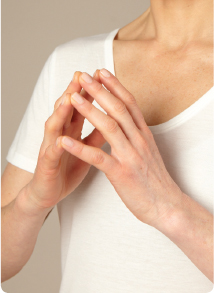
This mudra helps you to remember things, allows you to tap into your intuition for guidance, and enhances your intellectual capacity by stimulating communication between the right and left hemispheres of the brain. Try it when you feel you have ‘lost the thread’ of a conversation or would like more focus.
In yoga philosophy, Hakini is the guardian of the doorway to higher consciousness. She personifies the energy of the ajna chakra, and is often depicted with six faces and four arms. Two of her hands are in Abhaya and Varada Mudras (see pages 140–41), representing fearlessness and forgiveness; the other two hold a drum, whose steady sound induces meditation, and a skull, symbolizing the mind.
HOW TO PRACTISE
Come into a sitting position (see pages 20–21) or stand. If you lie down you might fall asleep. Press the tip of each finger against the tip of the same finger on the other hand. With eyes open or closed, look up slightly, directing your gaze toward your ajna chakra at the centre of your brow. For extra emphasis, gently tap your fingertips together. Hold for 5–10 deep breaths.
HOW IT WORKS
Each fingertip stimulates and balances the respective element and rebalances the energy of your ajna chakra.
 ACCOMPANYING BREATHING: PRACTISING THIS MÜDRA DEEPENS RESPIRATION, HELPFUL WHEN MULLING SOMETHING OVER OR TRYING TO SOLVE A PROBLEM. EACH TIME YOU INHALE AS YOU HOLD THE MUDRA, BRING THE TIP OF YOUR TONGUE TO THE HARD RIDGE BEHIND YOUR TEETH. RELAX YOUR TONGUE AS YOU EXHALE.
ACCOMPANYING BREATHING: PRACTISING THIS MÜDRA DEEPENS RESPIRATION, HELPFUL WHEN MULLING SOMETHING OVER OR TRYING TO SOLVE A PROBLEM. EACH TIME YOU INHALE AS YOU HOLD THE MUDRA, BRING THE TIP OF YOUR TONGUE TO THE HARD RIDGE BEHIND YOUR TEETH. RELAX YOUR TONGUE AS YOU EXHALE.
Integrating Brain Hemispheres Gesture
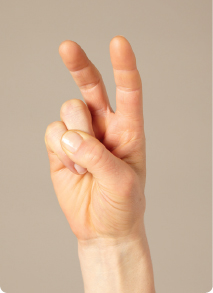
Used in kinesiology, Samasti Mudra encourages both hemispheres of the brain to communicate more effectively, so you can express yourself more fully and think intuitively (right-brain function) as well as objectively and rationally (left-brain). Samasti is the Sanskrit word for ‘integration’. Samasti Mudra is especially effective alternated with Sankalpa Mudra (see page 83) – try them in turn while breaking from computer work. Sankalpa Mudra enhances your ability to see the ‘big picture’ while Samasti integrates your various brain functions.
HOW TO PRACTISE
Come into a sitting position (see pages 20–21), stand, walk or lie down. Fold down the ring and little fingers of each hand so the fingertips touch their respective palms. Press on the backs of the bent fingers with the thumb of the same hand. Keep your index and middle fingers extended and relaxed. Hold for 4 minutes six times daily, waiting at least 20 minutes between sessions.
HOW IT WORKS
By holding down your ring and little fingers, you reduce the heavy effect of the kapha (see pages 18–19) elements of earth and water on your mental faculties. This releases your mind from restraints and helps to integrate its components.
 ACCOMPANYING VISUALIZATION: WHEN YOU FEEL STUCK WITH A PROJECT OR DON’T KNOW HOW TO PROCEED, GO FOR A LONG WALK WITH YOUR HANDS IN SAMASTI MUDRA. FOCUS ON YOUR BREATH: BREATHE IN FOR FOUR STEPS AND OUT FOR FOUR. YOUR MIND WILL CLEAR AND AN IMAGE OF THE WAY FORWARD WILL PRESENT ITSELF.
ACCOMPANYING VISUALIZATION: WHEN YOU FEEL STUCK WITH A PROJECT OR DON’T KNOW HOW TO PROCEED, GO FOR A LONG WALK WITH YOUR HANDS IN SAMASTI MUDRA. FOCUS ON YOUR BREATH: BREATHE IN FOR FOUR STEPS AND OUT FOR FOUR. YOUR MIND WILL CLEAR AND AN IMAGE OF THE WAY FORWARD WILL PRESENT ITSELF.
Overactive Mind Relief Gesture
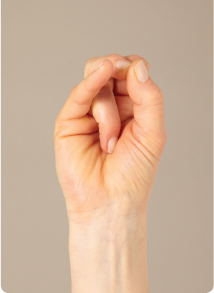
Maha-shirsha means ‘great head’ in Sanskrit. This is the mudra to turn to for relief from headaches, particularly migraines. It takes the edge off tension, eliminates sinus congestion and also helps you to clear your mind when you have too much to think about. This mudra is also useful whenever you experience a period of acute stress.
HOW TO PRACTISE
Come into a sitting position (see pages 20–21) or lie on your back with your feet flat on the floor. Practise with either or both hands. Curl your ring finger down into your palm. Bring the tips of your index and middle fingers to touch the tip of your thumb. Extend your little finger. Close your eyes and breathe gently. Hold for as long as feels comfortable and repeat as required. For chronic headaches, practice for 8–15 minutes daily.
HOW IT WORKS
By using your ring finger (earth element), which represents stability, to push on the palm (the mind), you reduce its fluctuations. The other elements are brought into balance as your thumb (fire), index finger (air) and middle finger (ether) come together.
 ACCOMPANYING BREATHING: AS YOU HOLD THE MUDRA, CLOSE YOUR EYES AND REGULATE YOUR BREATH, BREATHING OUT FOR A COUNT OF 8 AND IN FOR A COUNT OF 4. YOU CAN ADJUST THE COUNT IF YOU WISH, BUT MAINTAIN THE RATIO OF 2:1. WITH EVERY EXHALATION, BREATHE A LITTLE MORE TENSION OUT OF YOUR BODY.
ACCOMPANYING BREATHING: AS YOU HOLD THE MUDRA, CLOSE YOUR EYES AND REGULATE YOUR BREATH, BREATHING OUT FOR A COUNT OF 8 AND IN FOR A COUNT OF 4. YOU CAN ADJUST THE COUNT IF YOU WISH, BUT MAINTAIN THE RATIO OF 2:1. WITH EVERY EXHALATION, BREATHE A LITTLE MORE TENSION OUT OF YOUR BODY.
Circle Universe Gesture

This mudra enhances overall quality of life; it relieves health problems, protects you from negativity and awakens your awareness of the transitory nature of existence. A mandala is a circular symbol with a geometric form representing the energy patterns of the universe. As you meditate on its form, you draw energy from the world outside and direct it toward your inner being to enhance your intuition and concentration.
HOW TO PRACTISE
Come into a sitting position (see pages 20–21). Start with your palms facing up with the little-finger sides touching. Cross your little fingers and press them into your palms with the thumbs of the opposite hands. Cross your middle fingers; press them apart from each other with the index fingers of the opposite hands. Keep your ring fingers as straight as possible and beside each other. Rest your hands in your lap (on a small cushion if more comfortable). Hold for 5–30 minutes.
HOW IT WORKS
By interlocking and pressing on the backs of the fingers, you reduce yet balance the influence of all the elements, with the exception of the ring fingers, which offer the stability and protection of the earth element.
 ACCOMPANYING MEDITATION: WITH HANDS IN THE MUDRA, SIT FACING A FLOWER. THROUGH HALF-CLOSED EYES GAZE AT THE TOP OF THE FLOWER. SLOWLY ROTATE YOUR GAZE CLOCKWISE AROUND THE FLOWER’S OUTER EDGE, NOTING COLOURS AND SHAPES. AFTER 3–5 ROUNDS, LET YOUR EYES SLOWLY SPIRAL INWARD. AFTER SEVERAL SITTINGS, REACH THE CENTRE.
ACCOMPANYING MEDITATION: WITH HANDS IN THE MUDRA, SIT FACING A FLOWER. THROUGH HALF-CLOSED EYES GAZE AT THE TOP OF THE FLOWER. SLOWLY ROTATE YOUR GAZE CLOCKWISE AROUND THE FLOWER’S OUTER EDGE, NOTING COLOURS AND SHAPES. AFTER 3–5 ROUNDS, LET YOUR EYES SLOWLY SPIRAL INWARD. AFTER SEVERAL SITTINGS, REACH THE CENTRE.
Closed-fist Gesture
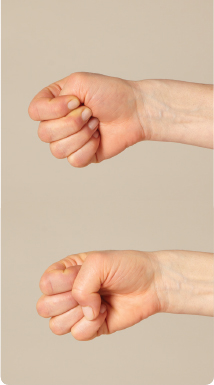
The closed hand is a universal symbol of strength, anger and aggression. We often respond unconsciously to negative emotions like anger or fear by clenching our fists. But if you practise Mushti Mudra in a conscious way, it can help to release irritation and frustration, while reducing the effects of stress on your heart and lowering high blood pressure. It also cures lethargy. This mudra stimulates the positive flow of energy to your liver and stomach, making an excellent time for practice directly after meals.
HOW TO PRACTISE
Come into a sitting or kneeling position (see pages 20–21), stand or move about. Using both hands, bend all your fingers and curl them into your palm, with your thumb either inside or resting on the outside of your fingers. Hold the mudra whenever you feel the need to release pent-up emotion, or practise for 5–15 minutes daily to relieve suppressed anger and frustration.
HOW IT WORKS
As all your fingers curl into the palm, so all the elements become concentrated and make your mind one-pointed.
 ACCOMPANYING VISUALIZATION: TO INCREASE YOUR PATIENCE, SIT IN VAJRASANA (SEE PAGE 99) WITH BOTH HANDS IN THIS MUDRA, RESTING ON YOUR THIGHS. CLOSE YOUR EYES AND LIPS; BREATHE THROUGH YOUR NOSE. REMEMBER A TIME YOU WERE ANNOYED. RELIVE THE EVENT, THIS TIME CALMLY, WITHOUT ANXIETY – YOU CAN REPLAY THIS WHEN STRESSED.
ACCOMPANYING VISUALIZATION: TO INCREASE YOUR PATIENCE, SIT IN VAJRASANA (SEE PAGE 99) WITH BOTH HANDS IN THIS MUDRA, RESTING ON YOUR THIGHS. CLOSE YOUR EYES AND LIPS; BREATHE THROUGH YOUR NOSE. REMEMBER A TIME YOU WERE ANNOYED. RELIVE THE EVENT, THIS TIME CALMLY, WITHOUT ANXIETY – YOU CAN REPLAY THIS WHEN STRESSED.
Yoga Mudra: Gesture of Yoga
This powerful yoga pose employs a hasta mudra, a hand gesture that seals in energy. As your hands press into the abdomen and pelvis, you stimulate nadi energy pathways and chakras in the lower part of your body. A fresh flow of blood rushes to this region, relieving constipation and stimulating your urinary system to function more efficiently. Your spine becomes more flexible and the variation with arms raised relieves tight muscles and improves circulation around the neck, upper back and shoulders, too. Practise first thing in the morning after drinking water with the juice of a lemon squeezed into it.
1 Kneel with your buttocks on your heels (or adopt Lotus Pose if you find it comfortable). Bring your hands into Mushti Mudra with your thumbs outside your fingers, on top of your curled index fingers.
2 Place the little-finger sides of your hands on your abdomen, on either side of your navel. In Lotus Pose, place your fists behind your heels.
3 Inhale deeply. As you exhale, bring your forehead toward the ground without allowing your buttocks to lift. You may rest your forehead on a cushion.
4 Hold between 10 seconds and 1 minute, breathing gently through both nostrils.
5 As a variation, in step 2, clasp your hands behind your back with palms as close together as possible. Straighten your elbows and lift your arms as you bring your forehead toward the ground.
6 When you have finished, open your eyes and gently shake out your hands from the wrists. Take 2–3 deep breaths before standing up.
